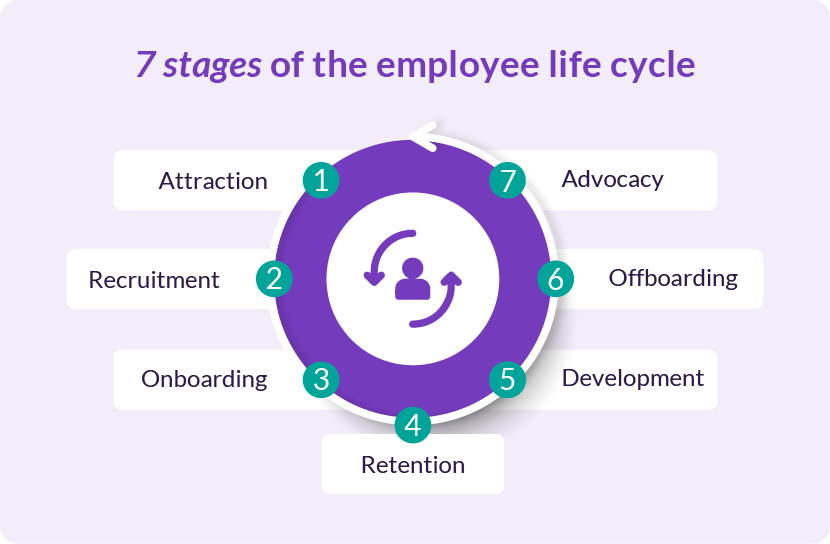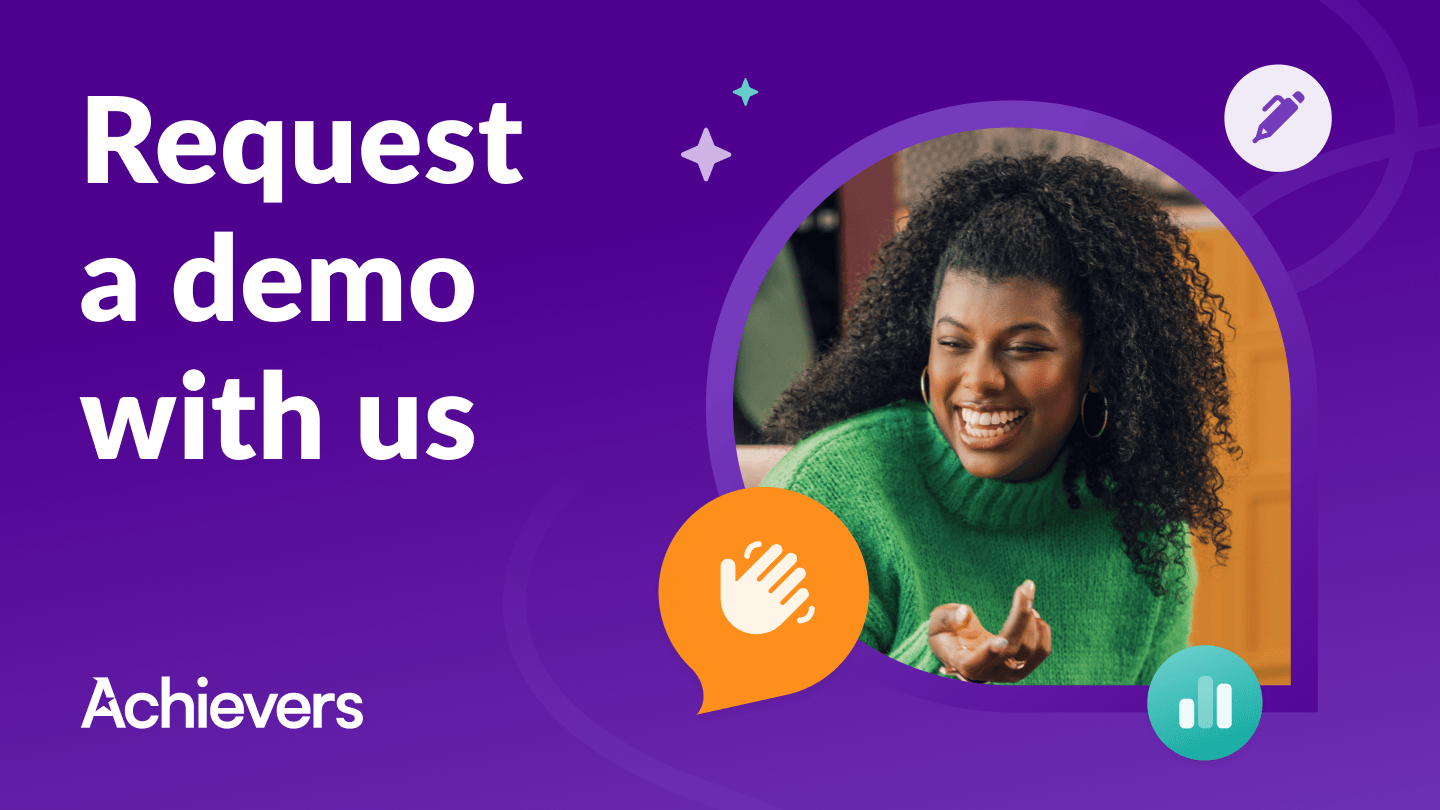Table of contents
The employee life cycle is a model for understanding the employee experience and journey through an organization from attraction to advocacy. Understanding these unique journeys — and how your organization can transform them for the better — can help inform HR strategies to boost engagement across each stage of the employee journey.
What is the employee life cycle?
The employee life cycle is a framework that HR can use to view the steps employees progress through during their time with an organization. The model is an excellent tool for solidifying HR’s grasp on how employees engage with their employers at different points in their career trajectory. It’s generally composed of 7 stages encompassing initial attraction to eventual separation:
- Attraction
- Recruitment
- Onboarding
- Retention
- Development
- Offboarding
- Advocacy
The employee life cycle can also be known as the HR life cycle, or simply the HR cycle, to describe the shifting roles of HR professionals and leaders in each of the above stages.
Why is understanding the employee life cycle important?
The employee life cycle is important because it allows HR to evaluate when employees feel engaged and perform at their best to optimize employee experience. Staying connected with employees through each stage has proved great for HR, including increased productivity and retention rate.
By viewing the employee experience through a holistic, connected lens, they can better determine where their efforts will make the greatest impact, whether that’s introducing an onboarding software or reshaping brand and culture to attract the best talent.
How to measure employee life cycle with surveys
The factors that lead to employee engagement are unique for every team member and change over time, so you need a way to survey employees at every stage of their journey. With employee surveys, you can do exactly that. Life cycle surveys provide insight into how employees feel about your company at the key moments of their experience, whether they’ve just been hired, received a promotion, or decided to leave.
Achievers’ 2024 Engagement and Retention Report found that employees surveyed three or more times a year are 45% more likely than those surveyed annually or less to say they see themselves having a long career with their company.
With an employee engagement solution that keeps all responses fully anonymized and confidential, your team members will share how they honestly feel about your company. HR and managers can then use this data to boost employee engagement at your organization and better craft your brand’s image to attract the talent you need.

What are the 7 stages of the employee life cycle?
Each stage of the employee life cycle is a critical part of a team member’s journey at your organization. Here’s a primer on all 7 stages, including how you can improve each and what questions related to each you should ask on your own employee life cycle survey.
1. Attraction
An employee’s journey happens before the recruitment process and begins when they first hear about your brand. The power of employer brand is very real: 55% of job seekers will stop applying after reading negative reviews about a company, and a staggering 92% of individuals would consider leaving their current job for an opportunity with no salary increase but with a company that has a great reputation. Make your organization somewhere top talent wants to be.
Build a culture of recognition
Think back to the last time you received recognition at work. Whether it was from a peer, manager, or even a member of your organization’s leadership team, it stuck with you, didn’t it? Recognition has the greatest impact on employee engagement, and organizations that rate their culture of recognition highly are 79% more likely to rate their employer brand highly as well.
Offer great incentives
Recognition is an incredibly powerful tool, but you need to complement it with equally attractive incentives. These range from the obvious — like compensation, health insurance, and retirement benefits — to incentives you may not have thought of. For example, profit sharing, tuition reimbursement, and additional flexibility in when employees work and what they work on are all great ways to incentivize candidates to join your company and motivate your current workforce.
Find out what employees love about your company
It’s hard to sell potential candidates on your organization if you’re not sure why your current employees have stuck with it. Once you find out what engages your employees, you’ll be able to double down on it and showcase it to the world. Use an engagement platform with employee life cycle surveys to regularly collect this information from all team members. In the surveys, ask what initially attracted employees to your organization, what they like best about it, and what they think could be improved to enhance their experience.
Market your brand
Marketing your employer brand is the first step to propelling all practices above. Start with developing your corporate website and social media presence, as this is many potential candidates’ introduction to your company, and a poor user experience can sour what would otherwise be a long, productive relationship. Ensure a professional online presence and highlight your unique workplace culture. Communicating with your target candidates on the platforms they prefer is another excellent way to attract the right talents and meet them where they are.
2. Recruitment
The recruitment process isn’t just about evaluating and selecting candidates. It’s also a chance for candidates to get a closer look at your company and decide whether it’s a good fit for them. Hiring employees who align with your culture can positively impact all subsequent stages of the employee life cycle. A winning recruitment process is one that brings in the right people at the right time.
Prioritize diversity when hiring.
Developing a diverse workforce has many benefits. Diverse companies see a higher bottom line, better employee performance, and even higher cash flow per employee. Building a diverse workforce starts with recruiting diverse candidates. Educate yourself on all the channels today’s diverse workforce uses, and then use them to engage with potential candidates. Finally, ask questions that reveal diversity of thought in your candidates and prioritize incorporating new perspectives to keep your organization fresh and vital.
Adapt your process for remote recruiting.
Many organizations have already moved most or all of their recruitment process online, but hiring remote employees involves far more than simply adopting the required technology. Employees have varying assumptions when it comes to how remote work functions, so be direct on where, when, and how they’ll be expected to work. Keep the hiring process as communal as possible by including additional team members in virtual interviews. And ensure that you’ve kept your process as thorough as it would be if you were recruiting in person.
Improve recruitment with employee life cycle surveys.
Employee life cycle surveys help your organization fine-tune its recruitment process. Ask new hires what they loved about their hiring experience and what could be improved. You can also take their temperature on a variety of key engagement factors and then see how their feelings change over time, giving you valuable insight into how your organization affects new hires.
3. Onboarding
Onboarding is that crucial step after recruitment encompassing everything needed to turn your candidate into a high-performing, acclimated employee. Communicating the nuances of the employee’s new position, handling administrative tasks, introducing them to your organizational culture — onboarding involves a lot, and it’s not easy. But it can make the difference between a successful team member and one who struggles and eventually departs early.
Make it a continuous process
Onboarding shouldn’t come to a stop after two weeks or a month. While this will likely be the most intense phase of onboarding, imposing any sort of hard stop to the onboarding process leaves employees feeling adrift. Instead, build in aspects of onboarding that continue for at least the first year the new employee is with your organization, like regular check-ins and training refreshers or updates. Maintaining this connection will keep employees on track and engaged for the initial stage of their employment and beyond.
Incorporate coaching
Having a coach or mentor can make all the difference for employees who are just joining your organization. Whether it’s a manager or simply a more experienced peer, a coach is there to encourage, guide, and support during both good times and bad. Set up a formal coaching program and watch the relationships between your new employees and veterans grow.
Clearly define the employee’s role
It may seem obvious, but if an employee doesn’t know exactly what their role entails, they’re not going to succeed at your company. Poorly crafted job descriptions — or failing to unambiguously communicate the expectations and responsibilities of the new employee — will lead to confusion and frustration. Carefully discuss and demonstrate everything related to the employee’s position, and encourage the employee to ask questions early and often.
Include employees beyond new hires
Onboarding isn’t just for new hires. Many transitions within your organization call for onboarding, and neglecting these employees can leave them feeling lost and unable to adjust. Employees coming back from parental or medical leave, transitioning from part-time to full-time, or even rejoining the company after a stint elsewhere need help getting up to speed and reorienting themselves.
4. Retention
The challenge of retaining an employee begins as soon as they are hired. It’s on your organization to earn your team members’ trust and prove that it deserves their continued loyalty day in and day out. Thankfully, many of the best ways to boost employee retention are the same as those your organization should already be prioritizing to attract and recruit talent. Practicing recognition, developing a winning culture, and focusing on the quality of team leaders are all effective ways to boost retention.
5. Development
Workforce development begins with a continuous learning approach that views each day and task as a chance to improve a skill or discover something new. Empower employees to pursue development opportunities, whether that takes the form of reimbursement for a seminar or covering the cost of tuition for an advanced degree. Providing recognition to those who achieve their development goals will keep your employees motivated to learn.
6. Separation
An employee’s departure doesn’t have to be a negative experience. Instead, view it as a learning opportunity — and a chance to turn your former employee into a lifelong advocate for your company. Change your perspective and start treating the goal of the offboarding process as helping the employee take the next steps of their career journey with dignity and confidence. You’ll find that this approach will pay regular dividends for your organization for years to come.
7. Advocacy
Just because someone has left your organization doesn’t mean the relationship between them and the organization ends. People stay in touch with their former colleagues and continue spreading the word about their past working experiences. Positive former employees can become vital supporters of your employer brand, and it’s crucial that organizations keep in touch with their old employees and keep the good memories going.
Challenges and solutions of the employee life cycle
Categorizing employees into distinct stages of the cycle can be a cookie-cutter exercise and create a narrow vision of the employee experience. Below are some challenges of the employee life cycle and solutions that can help the HR team overcome them while still referring to the framework when needed.
1. Employees as individuals, not workers
Whether it’s celebrating a birthday or reaching an important milestone like buying a new house, employees experience many moments in their personal lives that the employee life cycle does not reflect. A deep understanding of your employees’ wants and needs comes from a sense of belonging and a trusting relationship with their manager.
2. Micro-moments at work
Employees want to feel acknowledged for their efforts, even if they don’t achieve every goal. Instead of rigidly following the employee life cycle model, employee recognition software can help HR leaders and managers track employees’ progress and learnings meaningfully and recognize micro-moments at work to show employees your support every step of the way.
Taking control of the employee life cycle
The employee life cycle is an amazing tool, but trying to get a grasp on each stage can be overwhelming.
Once you’ve got a grasp on it at your company, you’ll want to start impacting it for the better, and recognition is the best way to positively affect every stage. Achievers Recognize, an award-winning employee recognition platform, makes showing appreciation to others a seamless, enjoyable part of the everyday work experience. Achievers customers are leaders in building a strong, engaging workplace culture.
With our software, our customers are:
- 54% more likely to give their culture of recognition a high rating than customers of other technology providers.
- 2.5 times more likely to see increased employee retention.
- 36% more likely to see an increase in employee engagement.
- 3.6 times more likely than customers of other providers to give recognition multiple times each month.
- 33% more likely to rate their employer brand higher than customers of Achievers’ competitors.
Ready to transform your workplace culture? Start building a culture of appreciation that drives recognition, growth, and business success.



